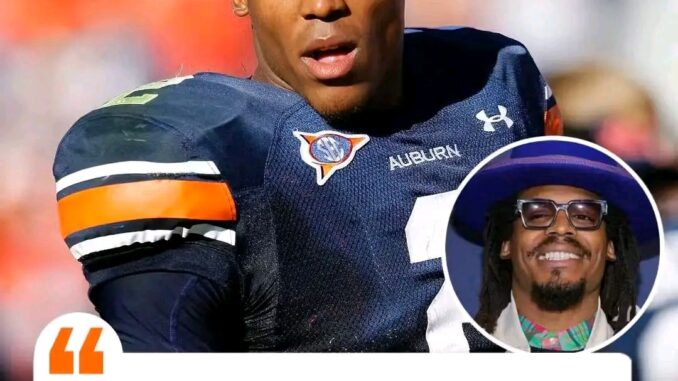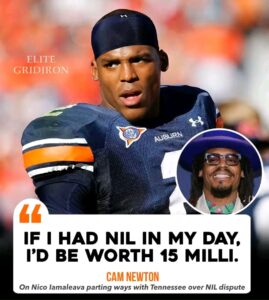
 HIGH-VALUE PLAYER💰 Cam Newton believes he would have been the highest-paid NIL college athlete ever if NIL existed while he was at Auburn.
HIGH-VALUE PLAYER💰 Cam Newton believes he would have been the highest-paid NIL college athlete ever if NIL existed while he was at Auburn.
Texas QB Arch Manning is currently the highest-paid NIL athlete, at $6.5 million.
Is this a good NIL valuation for Cam Newton’s talents in college?
Cam Newton’s assertion that he would have been the highest-paid NIL (Name, Image, and Likeness) college athlete of all time is not only plausible—it’s compelling when placed in the broader context of his 2010 season at Auburn University.
NIL deals are designed to reward athletes for the economic value they generate through public interest, brand leverage, and on-field performance.
By these standards, Newton’s claim carries significant weight.
To evaluate whether he would be worth more than Arch Manning’s $6.5 million valuation, we must consider Newton’s dominance, marketability, and cultural impact during his collegiate career, and how these factors align with current NIL dynamics.
Cam Newton’s College Impact
In 2010, Cam Newton delivered one of the most electrifying and dominant seasons in college football history.
In just one year at Auburn, he won the Heisman Trophy, led his team to a national championship, and posted astonishing statistics: over 2,800 passing yards, 1,400 rushing yards, and 50 total touchdowns.
Newton wasn’t just productive—he was transcendent.
His size, athleticism, and charisma made him a national phenomenon, attracting massive media coverage and fan engagement.
Auburn’s games were must-see events, and Newton was the engine behind that attention.
When considering NIL value, this level of influence would have translated into high-demand marketing opportunities.
In today’s NIL landscape, athletes are paid not just for their skills, but for the attention and engagement they bring.
Newton was not just a good player; he was a superstar whose persona extended far beyond the football field. Social media, sports talk shows, and college campuses across the nation revolved around his exploits.
If the NIL rules had existed in 2010, Newton’s commercial appeal would have been nearly unmatched.
Comparing to Arch Manning
Arch Manning, the current highest-paid NIL athlete at $6.5 million, carries a powerful last name, significant high school hype, and immense potential.
However, it’s important to note that Arch has not yet started a game at Texas and has not contributed on-field results at the collegiate level.
His valuation is based almost entirely on brand projection, lineage, and potential marketability.
In contrast, Newton’s 2010 season combined actual, generational performance with exceptional marketability.
That combination is rare. While Arch has a long runway ahead, he has yet to achieve anything close to the accomplishments Newton amassed in one season.
Therefore, a valuation exceeding $6.5 million for Newton is not just plausible—it would likely be conservative in today’s NIL market.
Consider the economic value Newton generated for Auburn and college football.
The university saw a massive spike in merchandise sales, ticket demand, and national exposure.
He lifted the Auburn brand into the national spotlight, brought the school a national championship, and had media outlets clamoring to cover every aspect of his journey.
In today’s ecosystem, that would have attracted a wide array of NIL endorsements—from apparel and automotive to media appearances and social media campaigns.
Social Media and Marketability
While Newton played in an era before Instagram and TikTok became dominant marketing platforms, his presence would have been tailor-made for them.
Today, NIL athletes like Olivia Dunne and Shedeur Sanders use their personalities and social media followings to generate revenue in addition to their on-field accomplishments.
Newton’s charisma, smile, fashion sense, and swagger would have made him a social media powerhouse.
It’s easy to imagine Newton with millions of followers, engaging in branded content, launching signature clothing lines, and appearing in commercials.
His personality matched the cultural zeitgeist of the time—and still does.
He understood branding before it became part of the athlete’s toolkit.
If he’d had access to modern NIL opportunities, Newton could have capitalized on platforms and brand partnerships in ways that went well beyond the football field.
Endorsements and Legacy Appeal
Major national brands like Nike, Gatorade, Beats by Dre, and Under Armour would have lined up to partner with Newton.
His style and appeal were a marketer’s dream.
In addition to local Alabama-based sponsors, Newton could have secured national deals that boosted his NIL value significantly.
Given that high-performing quarterbacks today can command deals in the multi-million dollar range, Newton’s combination of excellence and marketability likely would have earned him $10–15 million, if not more.
Furthermore, Newton was a household name. He transcended regional fame.
Even casual sports fans knew who he was and what he was doing on the field. In today’s NIL ecosystem, this sort of national appeal is rare and highly valuable.
Think about how Bryce Young, Caleb Williams, and others leveraged their fame—Newton’s aura and accomplishments dwarfed theirs in many ways.
Cultural and Economic Timing
NIL valuations are also about timing and context.
Newton played at a time when there was no NIL opportunity, and thus, no market to fully value his contributions.
Today, athletes benefit from digital platforms, influencer culture, and a broader understanding of branding.
Newton’s peak occurred before this environment existed—but if we retroactively placed his 2010 season into 2025’s NIL context, the numbers would explode.
Moreover, the demand for star college athletes is higher than ever.
Universities, collectives, and brands are willing to invest heavily to align themselves with transformative talents.
If Newton’s college career occurred today, his NIL bidding war would have been unprecedented, especially considering Auburn’s deep-pocketed boosters and the SEC’s prominence in the college football economy.
The Intangibles
Lastly, Newton had the “it” factor. Some athletes just carry a sense of magnetism that makes them more than players—they become symbols of a moment, of a movement.
Newton was that in 2010. That season was unforgettable not just because Auburn won, but because of how they won—with flair, resilience, and a quarterback who made every game a spectacle.
In today’s NIL system, that magic would have translated to sustained brand interest, potential media deals, reality TV-style content, and major digital revenue streams.
Conclusion
Cam Newton’s belief that he would have been the highest-paid NIL athlete of all time is not just reasonable—it is likely accurate.
Comparing him to Arch Manning, whose $6.5 million valuation is based on potential rather than performance, highlights the disparity in immediate impact and star power.
Newton delivered one of the most dominant college football seasons ever, elevated Auburn’s national profile, and possessed the charisma and marketability that brands crave.
If the 2010 version of Cam Newton existed in today’s NIL era, it is entirely conceivable that his valuation would exceed $10 million.
In fact, it’s difficult to identify another college athlete in recent memory whose combination of talent, timing, and star power would eclipse Newton’s in value.
Would you like a visual breakdown comparing Newton’s 2010 impact to current NIL athletes?
Leave a Reply